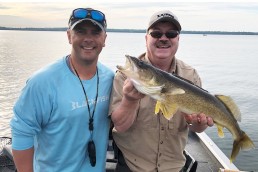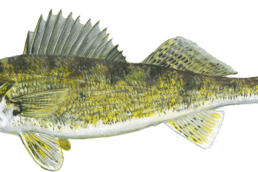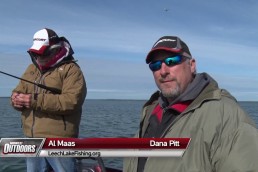Spinner Fishing 101 for Leech Lake Walleyes
SHARE THIS POST
As spring fishing segues to early summer on gigantic Leech Lake in north-central Minnesota, a different pattern emerges. Fish coming out of shallow, sandy post-spawn areas, and having formerly devoured schools of spottail shiners, are now in search of the main ingredient of walleye gumbo: crayfish. While crayfish can be found in a lot of places on Leech, one of the best areas is the system of rock bars and reefs out on the main lake. In order to efficiently and effectively pluck them from the rocks, you need to utilize spinners. Spinners allow you to cover water and are just plain effective.
Let’s cover productive setups and likely haunts to check out on Leech Lake.
Rod and reel
Before you even buy a spinner, make sure you have the right rod, reel and fishing line. Personally, I prefer using telescoping rods. As a guide, it is all about maximizing space and, with telescopic rods, I can take advantage of their long length when extended, yet they will fit in my rod lockers when collapsed.
The main rock areas on leech are 15 feet or less in depth, and it can be easy to spook fish on calm days. Longer rods give fishermen a distinct advantage when trying to get spinners out away from the boat. This proves especially effective when fishing shallower water where you may spook fish. It also allows you to not have to worry about using planer boards, which can be cumbersome. Line counter reels, paired with 10-pound-test monofilament, can also help you dial in productive depths when gauging how far out the baits are running behind the boat.
So many blades, so little time…
There are so many different spinners on the market today. Where does a walleye fisherman start?
Paramount to any effective trolling program is finding or tying a spinner rig that has high-quality components from the swivel down to the hook. There are plenty of pre-tied rigs out there; grab a variety of brands and see what works for you.
For me, I like to tie my own spinners for my trips, and I keep it pretty simple. I use 10-pound Vanish fluorocarbon leaders approximately 5 feet in length, #4 Gamakatsu hooks, and for spinners, I either the standard Colorado blades or Smile blades from Mack’s. Sometimes I am trying to match the hatch and will employ orange blades to mimic crayfish; other times I am experimenting with green, purple or whatever color I think looks good. Also, in recent years, I have switched out the 2-hook worm harness approach and substituted a slow death hook, which has proven as effective.
Another consideration is the size of the blades being used. Standard spinners generally come with Colorado blades in sizes 3, 4 and 5. The size is a key component for the speed at which you troll the spinners. With 3’s, I can go approximately 1.0 to 1.2 mph; with larger sizes such as a 5, you will need to increase speed to 1.3 to 1.5mph to keep it off the bottom. These larger blades will put off a larger flash and vibration in the water. Smaller sizes allow you to troll slower and offer a finesse approach. This is where Mack’s Smile blades come in handy. With these, I can go as slow as .7 mph as the Smile effectively spins and gives off flash.
Are you enjoying this post?
You can be among the first to get the latest info on where to go, what to use and how to use it!
What bar?
No, not the bar with stools and cold pops. I am talking rock bars on Leech lake: Annex, Submarine, North Bar, Mokey Reef and a host of others. The reality is that they all hold fish at different times or will have biters at different parts of the day.
Begin your search on the side the wind is blowing into, because more times than not, that’s where they’ll be hanging out. Cruise the structure, and as you move along set waypoints, creating a trolling pattern to chart a course to attack these fish. Once you have your waypoints set, deploy your spinners into the depths and begin trolling.
The speed at which you troll the spinners will be dictated by the mood of the fish. Oftentimes, something between .7 and 1.2 mph is a good starting point. When you do hook up, note depth and speed. Optimally, you are using your bowmount electric trolling motor for a stealthier approach. However, the main lake on Leech can get a little bumpy when the wind blows, and you may need to combine your big motor and bowmount to get the job done.
Finally
I am there, I am ready, now what? Too many people want to overthink spinners, and male ego also gets in the way by demanding that we hold the rod. While there are days—windy days for sure, or light-biting day—when this is an advantage. But in general, I leave the rod in the rod holder. People will disagree with me, and that is fine. However, if you want to put more fish in the boat, don’t hold the rod.
No, that is not a typo. I said don’t hold the rod. Get you bait to the depth you need, put the rod in a holder and leave it be! The slight stretch in your monofilament, along with the longer rod, will set the hook themselves.
When you get bit, be patient: Let the rod load, reel down while it is in the holder, and simultaneously lift the rod out of the holder and begin reeling. Overthink it if you wish, but keeping it simple is the way to go.
Spinners and walleyes are something that have been fundamental for many decades. Whether it is the traditional red/white Colorado blade that was ever-so-popular years ago, or the new and improved Smile blades that are made today, with the right presentation, spinners can put a load of Leech Lake walleyes in the boat this summer for you.
Become a MidWest Outdoors Insider here!
MWO
SHARE THIS POST
Did you enjoy this post?
You can be among the first to get the latest info on where to go, what to use and how to use it!
Jim Ernster
Jim Ernster is a guide and pro staffer with Leisure Outdoor Adventures, a premier fishing guide service in Walker, Minn. Check them out at leisureoutdooradventures.com or call 855-562-4665.



